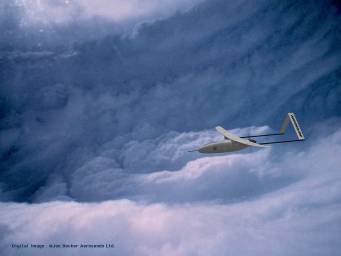UEVs
 New Scientist reports on the planned use of the Aerosonde drone to measure the conditions inside a hurricane, including the temperature, pressure, humidity and wind velocity. The Aerosonde will go where no human-crewed aircraft could -- just a few hundred meters above the ocean, where the winds of a hurricane are at their peak. The $50,000 unmanned air vehicle (UAV) is powered by a modified model aircraft engine, and carries meteorological sensors, GPS and (of course) a small computer.
New Scientist reports on the planned use of the Aerosonde drone to measure the conditions inside a hurricane, including the temperature, pressure, humidity and wind velocity. The Aerosonde will go where no human-crewed aircraft could -- just a few hundred meters above the ocean, where the winds of a hurricane are at their peak. The $50,000 unmanned air vehicle (UAV) is powered by a modified model aircraft engine, and carries meteorological sensors, GPS and (of course) a small computer.
This is very cool, and I look forward to hearing about the results (they haven't had any luck so far, because no hurricanes have come close enough to the mainland US). But while reading the story, I was struck by a connection to something I linked to a few months ago: the Polecat unmanned combat air vehicle, 90% of which is produced by a 3D printer.
At the time, I drew a connection between the Polecat story and the possible use of UAVs by Hezbollah in the recent Lebanon conflict. The Aerosonde story is a better connection, however, and it ties into my larger argument about the democratization of environmental study. As 3D printing technology becomes more readily available, I expect to see the proliferation of small, cheap robotic vehicles for environmental study -- unmanned environmental vehicles, or UEVs, if you will. Certainly research groups will want them, and university students will probably be close behind. As the price drops, and the number of designs grows, you might start to see them in the hands of interested citizens.
And while the UEV that inspired this post is an aircraft, there's no reason why mobile environmental sensors would be limited only to the air.
3D printing might turn out to be a transformative technology for environmental research.





